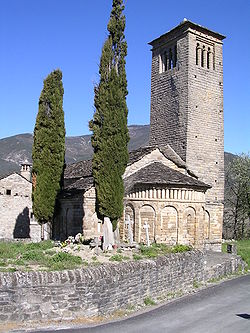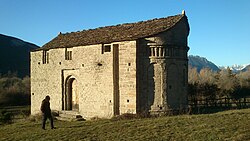User:AyuntamientoSabiñanigo/Churches of Serrablo

It is known by the name of Serrablo churches a group of churches built in the natural region of Serrablo, upper basin of the Gállego River (Alto Gállego region, in Aragón, Spain), generally on the left bank, between the 10th and 11th centuries is known by the name of the Serrablo churches. according to the various proposed hypotheses. At the end of the 11th century and the beginning of the 12th century its area of influence expanded and, for this reason, churches with similar characteristics were built on the right bank of the Gállego, as may be the case in Barós and Lerés.
Depending on the two main interpretative currents regarding these churches, they are considered either Mozarabic, built since the 10th century by Christian communities under Islamic rule (Antonio Durán Gudiol and the Friends of Serrablo association); or (according to other art historians at the University of Zaragoza) pre-Romanesque or a first Romanesque of the 11th century that emerged at the beginning of the kingdom of Aragon. In this case it would be architecture from an early Romanesque period with elements of Mozarabic art taken from Muslim architecture and with influences from Lombard Romanesque.
These churches were classified as Historical-Artistic Monuments on September 29, 1982 (with the exception of the Lárrede church, recognized in 1931) thanks in large part to the restoration and dissemination work of the Friends of Serrablo Association, founded in 1971.
Characteristics
[edit]
They generally adopt a simple structure. They have a single rectangular nave, small in size, topped with a semicircular apse, to which a bell tower is attached.
The head or apse is usually decorated with an upper frieze of thick vertical batons, under which a series of blind arches appear molded. The wall appears reinforced by narrow pilasters (lesenas).
At the top of the tower there are openings with two and three horseshoe arches supported by rough columns that sometimes end in unadorned capitals. Both the access door to the temple and the openings, which are very narrow and small in size like arrow slits, are usually framed with an alfiz. The arches are semicircular or horseshoe arches closed with irregular voussoirs; the keystone of the arch is often missing, which gives an idea of the rudimentary nature of the construction.
Monumental sculpture is very rare in these churches.
The church of San Pedro de Lárrede is considered the prototype of this entire homogeneous architectural group.
Churches of Serrablo and its area of influence
[edit]

- Arto. San Martín
- Asieso. San Andrés
- Barós. San Fructuoso
- Basarán. San Urbez San Miguel, trasladada a Formigal
- Biescas. San Juan de Busa
- Espierre. San Juan y Santa María
- Gavín San Bartolomé de Gavín, monasterio de San Pelay, Santa María, trasladada a Sabiñánigo
- Isún de Basa. Santa María
- Javierrelatre. Santos Reyes

- Lárrede. San Pedro
- Lasieso. San Pedro
- Latre. San Miguel
- Lerés. San Miguel
- Oliván. San Martín
- Ordovés. San Martín
- Orna. San Miguel
- Orós Bajo. Santa Olaria
- Orús. San Juan
- Otal
- Rasal
- Satué. San Andrés
- Susín. Santa Olaria
References
[edit]Bibliography
[edit]- Durán Gudiol, A. Guía monumental y artística de Serrablo. A. Durán Gudiol y D.J. Buesa Conde. Huesca, Instituto de Estudios Altoaragoneses, 1987.
- Esteban Lorente, J.F. Nacimiento del arte románico en Aragón: Arquitectura. J. F. Esteban Lorente, F. Galtier Martí y M. García Guatas. Zaragoza, Caja de Ahorros de la Inmaculada, 1982.
- Galtier Martí, F. Las iglesias lombardistas de Aragón y Serrablo. Zaragoza, El Autor, 2019.
- Iglesias Costa, M. Arquitectura románica. Siglos X, XI, XII y XIII. Barcelona, Akribós, 1987.
- Pérez González, J.M. (dir). Enciclopedia del románico en Aragón. Huesca. Volumen I. Jacetania. Aguilar de Campoo, Fundación Santa María la Real del Patrimonio Histórico, 2006.
- Serrablo. Sabiñánigo, Amigos de Serrablo. 1977- . Periodicidad trimestral
External links
[edit]- Gobierno de Aragón (2021). Iglesias de Sarrablo [Aplicación móvil]. Google Play
- Guía digital del arte románico aragonés
- Guía del Arte mozárabe en el Serrablo de Huesca en arteguias.com
- Las iglesias mozárabes de "El Serrablo"
- Mapa interactivo de la arquitectura mozárabe y románica del alto Gállego con vínculos a cada monumento
- El románico del Gállego (1/5), 2/5 3/5 4/5 5/5, www.arquivoltas.com
[[Category:Spanish art]]
